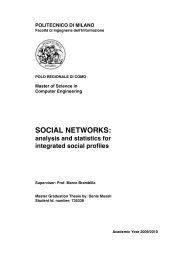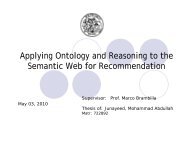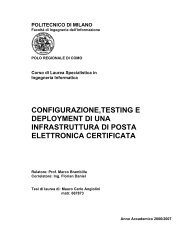Thesis full text (PDF) - Politecnico di Milano
Thesis full text (PDF) - Politecnico di Milano
Thesis full text (PDF) - Politecnico di Milano
Create successful ePaper yourself
Turn your PDF publications into a flip-book with our unique Google optimized e-Paper software.
5. Related Work<br />
This section reviews existing design frameworks for ontology based semantic Web applications.<br />
Hera [63] is a modeling language for enriching the contents of Web Information Systems with<br />
knowledge resulting from <strong>di</strong>fferent sources. Its design approach encloses the steps for modeling<br />
the domain knowledge and the hyperme<strong>di</strong>a structure and features, producing respectively the<br />
Conceptual (CM), and the Application (AM) and Presentation Model. The representation syntax<br />
of the application domain is RDF(S). The mapping between each data source schema and the<br />
CM is also defined in RDF. The AM models the contents and navigational links of the<br />
application interfaces in terms of classes and properties in the CM. The Hera approach defines<br />
RQL data extraction mechanisms upon the structure of knowledge contained in the CM. It does<br />
not provide any means for extracting the knowledge structure or for making inferences on it to<br />
derive new relations.<br />
Hera-S [64] covers some of the limitations of Hera, by enabling knowledge update through<br />
hyper<strong>text</strong> interfaces. The domain is modeled with OWL, and the query language interpreted by<br />
Sesame is SeRQL. Queries are not generated automatically by the system. The developer<br />
expresses the appropriate SeRQL queries and parameters within the body of extraction<br />
components.<br />
These two approaches suffer of some common limitations:<br />
• no automatic means are provided for manipulating the knowledge structure;<br />
• the developer must be aware knowledgeable of OWL, RDF(S), and SeRQL, because no<br />
abstraction on the implementation details of the queries is provided;<br />
• the built architecture is rather monolithic and not open to extensibility.<br />
The Semantic Hyperme<strong>di</strong>a Design Method (SHDM) [65] is an extension of the OOHDM<br />
approach for modeling semantic Web applications. It incorporates the conceptual modeling of<br />
86



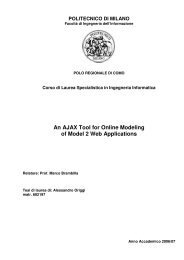
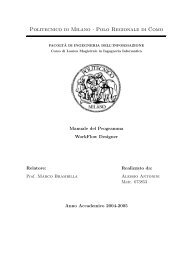
![Full text preview of the chapter [PDF] - Politecnico di Milano](https://img.yumpu.com/44021924/1/180x260/full-text-preview-of-the-chapter-pdf-politecnico-di-milano.jpg?quality=85)
